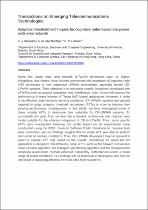 ResearchSpace
ResearchSpace
Adaptive threshold techniques for cognitive radio-based low power wide area network
JavaScript is disabled for your browser. Some features of this site may not work without it.
- ResearchSpace
- →
- Research Publications/Outputs
- →
- Journal Articles
- →
- View Item
| dc.contributor.author |
Onumanyi, Adeiza J

|
|
| dc.contributor.author |
Abu-Mahfouz, Adnan MI

|
|
| dc.contributor.author |
Hancke, GP

|
|
| dc.date.accessioned | 2020-09-21T12:31:03Z | |
| dc.date.available | 2020-09-21T12:31:03Z | |
| dc.date.issued | 2020-02 | |
| dc.identifier.citation | Onumanyi, A.J., Abu-Mahfouz, A.M.I. & Hancke, G.P.2020. Adaptive threshold techniques for cognitive radio-based low power wide area network. Transactions on Emerging Telecommunications Technologies, vol. 31(e), pp. 1-19 | en_US |
| dc.identifier.issn | 1124-318X | |
| dc.identifier.issn | 2161-3915 | |
| dc.identifier.uri | https://doi.org/10.1002/ett.3908 | |
| dc.identifier.uri | https://onlinelibrary.wiley.com/doi/full/10.1002/ett.3908 | |
| dc.identifier.uri | http://hdl.handle.net/10204/11585 | |
| dc.description | Copyright: 2019, Wiley Online Library. Due to copyright restrictions, the attached PDF file contains the abstract of the full-text item. For access to the full-text item, please consult the publisher's website. | en_US |
| dc.description.abstract | Some low power wide area network (LPWAN) developers such as Sigfox, Weightless, and Nwave, have recently commenced the integration of cognitive radio (CR) techniques in their respective LPWAN technologies, generally termed CR-LPWAN systems. Their objective is to overcome specific limitations associated with LPWANs such as spectra congestion and interference, which in turn will improve the performance of many Internet of Things (IoT)-based applications. However, in order to be effective under dynamic sensing conditions, CR-LPWAN systems are typically required to adopt adaptive threshold techniques (ATTs) in order to improve their sensing performance. Consequently, in this article, we have investigated some of these notable ATTs to determine their suitability for CR-LPWAN systems. To accomplish this goal, first, we describe a network architecture and physical layer model suitable for the effective integration of CR in LPWAN. Then, some specific ATTs were investigated following this model based on an experimental setup constructed using the B200 Universal Software Radio Peripheral kit. Several tests were conducted, and our findings suggest that no single ATT was able to perform best under all sensing conditions. Thus, CR-LPWAN developers may be required to select a suitable ATT only based on the specific condition(s) for which the IoT application is designed. Nevertheless, some ATTs such as the forward consecutive mean excision algorithm, the histogram partitioning algorithm and the nonparametric amplitude quantization method achieved noteworthy performances under a broad range of tested conditions. Our findings will be beneficial to developers who may be interested in deploying effective ATTs for CR-LPWAN systems. | en_US |
| dc.language.iso | en | en_US |
| dc.publisher | Wiley Online Library | en_US |
| dc.relation.ispartofseries | Workflow;23673 | |
| dc.subject | Adaptive threshold techniques | en_US |
| dc.subject | ATT | en_US |
| dc.subject | Cognitive radio techniques | en_US |
| dc.subject | Low Power Wide Area Network | en_US |
| dc.subject | LPWAN | en_US |
| dc.title | Adaptive threshold techniques for cognitive radio-based low power wide area network | en_US |
| dc.type | Article | en_US |
| dc.identifier.apacitation | Onumanyi, A., Abu-Mahfouz, A. M., & Hancke, G. (2020). Adaptive threshold techniques for cognitive radio-based low power wide area network. http://hdl.handle.net/10204/11585 | en_ZA |
| dc.identifier.chicagocitation | Onumanyi, AJ, Adnan MI Abu-Mahfouz, and GP Hancke "Adaptive threshold techniques for cognitive radio-based low power wide area network." (2020) http://hdl.handle.net/10204/11585 | en_ZA |
| dc.identifier.vancouvercitation | Onumanyi A, Abu-Mahfouz AM, Hancke G. Adaptive threshold techniques for cognitive radio-based low power wide area network. 2020; http://hdl.handle.net/10204/11585. | en_ZA |
| dc.identifier.ris | TY - Article AU - Onumanyi, AJ AU - Abu-Mahfouz, Adnan MI AU - Hancke, GP AB - Some low power wide area network (LPWAN) developers such as Sigfox, Weightless, and Nwave, have recently commenced the integration of cognitive radio (CR) techniques in their respective LPWAN technologies, generally termed CR-LPWAN systems. Their objective is to overcome specific limitations associated with LPWANs such as spectra congestion and interference, which in turn will improve the performance of many Internet of Things (IoT)-based applications. However, in order to be effective under dynamic sensing conditions, CR-LPWAN systems are typically required to adopt adaptive threshold techniques (ATTs) in order to improve their sensing performance. Consequently, in this article, we have investigated some of these notable ATTs to determine their suitability for CR-LPWAN systems. To accomplish this goal, first, we describe a network architecture and physical layer model suitable for the effective integration of CR in LPWAN. Then, some specific ATTs were investigated following this model based on an experimental setup constructed using the B200 Universal Software Radio Peripheral kit. Several tests were conducted, and our findings suggest that no single ATT was able to perform best under all sensing conditions. Thus, CR-LPWAN developers may be required to select a suitable ATT only based on the specific condition(s) for which the IoT application is designed. Nevertheless, some ATTs such as the forward consecutive mean excision algorithm, the histogram partitioning algorithm and the nonparametric amplitude quantization method achieved noteworthy performances under a broad range of tested conditions. Our findings will be beneficial to developers who may be interested in deploying effective ATTs for CR-LPWAN systems. DA - 2020-02 DB - ResearchSpace DP - CSIR KW - Adaptive threshold techniques KW - ATT KW - Cognitive radio techniques KW - Low Power Wide Area Network KW - LPWAN LK - https://researchspace.csir.co.za PY - 2020 SM - 1124-318X SM - 2161-3915 T1 - Adaptive threshold techniques for cognitive radio-based low power wide area network TI - Adaptive threshold techniques for cognitive radio-based low power wide area network UR - http://hdl.handle.net/10204/11585 ER - | en_ZA |





